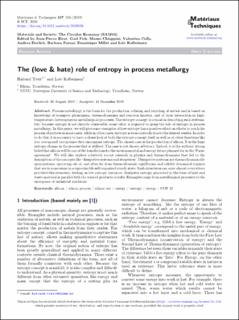| dc.contributor.author | Tveit, Halvard | |
| dc.contributor.author | Kolbeinsen, Leiv | |
| dc.date.accessioned | 2021-02-09T09:00:57Z | |
| dc.date.available | 2021-02-09T09:00:57Z | |
| dc.date.created | 2020-01-24T13:49:29Z | |
| dc.date.issued | 2019 | |
| dc.identifier.citation | Matériaux & Techniques. 2019, 107 (5), . | en_US |
| dc.identifier.issn | 0032-6895 | |
| dc.identifier.uri | https://hdl.handle.net/11250/2726776 | |
| dc.description.abstract | Abstract. Process metallurgy is the basis for the production, refining and recycling of metals and is based on knowledge of transport phenomena, thermodynamics and reaction kinetics, and of their interaction in high temperature, heterogeneous metallurgical processes. The entropy concept is crucial in describing such systems, but, because entropy is not directly observable, some effort is required to grasp the role of entropy in process metallurgy. In this paper, we will give some examples of how entropy has a positive effect on efforts to reach the process objectives in some cases, while in other cases, entropy acts in contradiction to the desired results. In order to do this, it is necessary to have a closer look at both the entropy concept itself as well as at other functions like free energy and exergy since they encompass entropy. The chosen case is the production of silicon. It is the huge entropy change in the process that is utilized. The case is not chosen arbitrary. Indeed, it is the authors’ strong belief that silicon will be one of the foundations for the environmental and energy future planned for in the “Parisagreement”. We will also explore relatively recent research in physics and thermodynamics that led to the description of the concepts like “dissipative systems and structures”. Dissipative systems are thermodynamically open systems, operating out of, and often far from thermodynamic equilibrium and exhibit dynamical regimes that are in some sense in a reproducible self-organized steady state. Such structures can arise almost everywhere provided this structure, feeding on low entropy resources, dissipates entropy generated in the form of heat and waste material in parallel with the wanted products/results. Examples range from metallurgical processes to the emergence of industrial symbiosis. Keywords: silicon / silicon process / silicon use / energy / entropy / exergy / COP 21 | en_US |
| dc.language.iso | eng | en_US |
| dc.publisher | EDP Sciences | en_US |
| dc.relation.uri | https://doi.org/10.1051/mattech/2019028 | |
| dc.rights | Navngivelse 4.0 Internasjonal | * |
| dc.rights.uri | http://creativecommons.org/licenses/by/4.0/deed.no | * |
| dc.title | The (love & hate) role of entropy in process metallurgy | en_US |
| dc.type | Journal article | en_US |
| dc.description.version | publishedVersion | en_US |
| dc.source.pagenumber | 8 | en_US |
| dc.source.volume | 107 | en_US |
| dc.source.journal | Matériaux & Techniques | en_US |
| dc.source.issue | 5 | en_US |
| dc.identifier.doi | 10.1051/mattech/2019028 | |
| dc.identifier.cristin | 1781614 | |
| dc.relation.project | Norges forskningsråd: 237738 | en_US |
| dc.description.localcode | © SCF, 2020 Licence Creative Commons This is an Open Access article distributed under the terms of the Creative Commons Attribution License (https://creativecommons.org/licenses/by/4.0), which permits unrestricted use, distribution, and reproduction in any medium, provided the original work is properly cited. | en_US |
| cristin.ispublished | true | |
| cristin.fulltext | original | |
| cristin.fulltext | original | |

